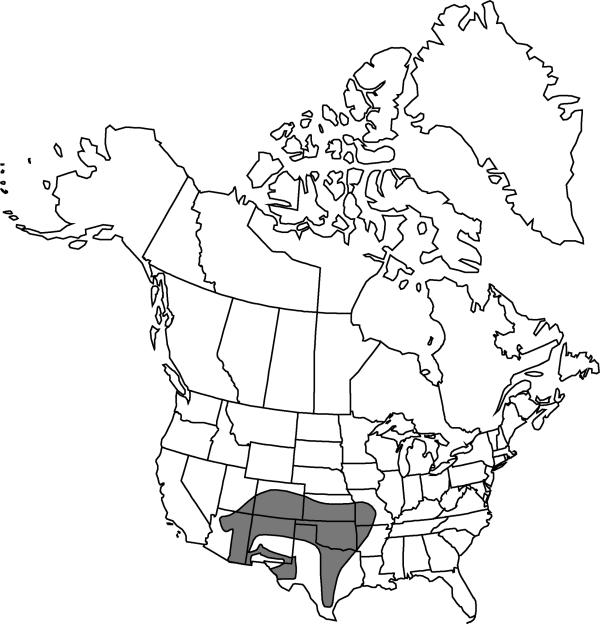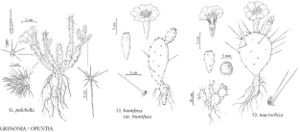Opuntia macrorhiza
Boston J. Nat. Hist. 6: 206. 1850.
Shrubs, forming clumps, 7.5–16 cm, sometimes from tuberlike rootstocks. Stem segments not easily detached, dark dull green, often cross wrinkled when stressed, flattened, obovate to circular, 5–11 × 3.5–7.5 cm, fleshy (to flabby and cross wrinkled when stressed), tuberculate, glaucous; areoles 5–6(–8) per diagonal row across midstem segment, oval to subcircular, 2–4 mm diam.; wool tan. Spines (0–)1–4 per areole, usually in distal areoles, erect to spreading, white to red-brown, acicular, straight, terete or 1 flattened, ± stout (0.5 mm diam. at base), longest to 60 mm. Glochids in dense tuft, pale yellow, tan to red-brown, aging brown, to 5 mm. Flowers: inner tepals yellow with red basal portions, 25–40 mm; filaments pale yellow; anthers yellow; style white; stigma lobes cream to yellowish. Fruits green to yellowish to dull red, stipitate, elongate-obovoid, 25–40 × 15–28 mm, fleshy, glabrous; areoles 16–28. Seeds tan, subcircular, 4–5 mm, thickish, warped; girdle broad, protruding to 0.5 mm. 2n = 44.
Phenology: Flowering late spring (May–Jun).
Habitat: Plains, chaparral, grassy woodlands, coniferous forests, sandy to loamy soils
Elevation: 100-2300 m
Distribution

Ariz., Ark., Colo., Kans., Mo., N.Mex., Okla., Tex., Utah, Mexico (Chihuahua).
Discussion
Opuntia macrorhiza hybridizes with the hexaploid O. engelmannii (apparently var. lindheimeri) forming the pentaploid O. ×edwardsii V. E. Grant & K. A. Grant. This hybrid is a small subshrub, 20–40 cm, with a mixture of widely spaced, unequal glochids and closely spaced, shorter glochids. Its major spines are gray, and its tepals are yellow or yellow with red bases. Those characteristics are similar to one parent or the intermediate of the two putative parents reported from Blanco and Guadalupe counties, central Texas.
Selected References
None.
